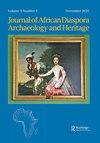屎、血、文物和眼泪:加纳海岸角城堡奴隶地牢的游客感知和考古遗迹
Q1 Arts and Humanities
Journal of African Diaspora Archaeology and Heritage
Pub Date : 2018-05-04
DOI:10.1080/21619441.2018.1578480
引用次数: 8
摘要
摘要在欧洲介入之前,在今天被称为加纳的部分地区,社区之间发生了非自愿的奴役、贸易和人类交换。然而,随着欧洲人的介入和随后的殖民主义,这种做法迅速演变成了令人发指的跨大西洋动产奴隶贸易。研究奴隶制的学者们知道,这种现象的物质遗迹和记忆一直存在。然而,公众如何参与奴隶制的过去,不仅仅取决于这种学术专业知识的传播。游客来到与奴隶有关的遗产地,通常已经通过公共话语和自己的学校教育大量接触了奴隶制的历史。在这些地点的公众参观也可能无法平等地传递所有类型的相关证据。历史证据可能比考古证据更受关注。纪念碑的建筑可能比不太明显的材料残留物更受关注。本文探讨了游客在加纳海岸角城堡的体验,特别关注游客对纪念碑和奴隶制历史的看法。我们分析了游客接触到海岸角城堡地牢中发现的考古遗迹信息以及该遗址更广泛的历史背景对这些看法的影响。本文章由计算机程序翻译,如有差异,请以英文原文为准。
Shit, Blood, Artifacts, and Tears: Interrogating Visitor Perceptions and Archaeological Residues at Ghana's Cape Coast Castle Slave Dungeon
ABSTRACT Involuntary servitude, trade, and exchange in humans occurred among communities in parts of what is today known as Ghana before the advent of European involvement. However, with Europeans’ involvement and subsequent colonialism, this practice rapidly evolved into the heinous transatlantic chattel slave trade. Scholars studying slavery know that the material vestiges and memories of this phenomenon persist in the present. Yet, how public audiences engage with slavery’s past is determined by more than the transmission of such academic expertise. Visitors arrive to slave-related heritage sites typically having already had significant exposure to histories of slavery through public discourse and their own schooling. Public tours at such sites also may not relay all types of relevant evidence equally. Historical evidence may be given more attention than archaeological evidence. A monument’s architecture may be given more attention than less obvious material residues. This article explores visitor experiences at Ghana’s Cape Coast Castle, with particular attention given to visitor perceptions of the monument and of the history of slavery. We analyze how these perceptions are affected by visitors’ exposure to information on archaeological residues identified in Cape Coast Castle’s dungeons and in broader historical contextualization of the site.
求助全文
通过发布文献求助,成功后即可免费获取论文全文。
去求助
来源期刊

Journal of African Diaspora Archaeology and Heritage
Arts and Humanities-History
CiteScore
0.80
自引率
0.00%
发文量
9
期刊介绍:
Journal of African Diaspora Archaeology and Heritage provides a focal point for peer-reviewed publications in interdisciplinary studies in archaeology, history, material culture, and heritage dynamics concerning African descendant populations and cultures across the globe. The Journal invites articles on broad topics, including the historical processes of culture, economics, gender, power, and racialization operating within and upon African descendant communities. We seek to engage scholarly, professional, and community perspectives on the social dynamics and historical legacies of African descendant cultures and communities worldwide. The Journal publishes research articles and essays that review developments in these interdisciplinary fields.
 求助内容:
求助内容: 应助结果提醒方式:
应助结果提醒方式:


